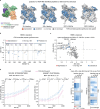Streptolysin O accelerates the conversion of plasminogen to plasmin
- PMID: 39587097
- PMCID: PMC11589678
- DOI: 10.1038/s41467-024-54173-6
Streptolysin O accelerates the conversion of plasminogen to plasmin
Abstract
Group A Streptococcus (GAS) is a human-specific bacterial pathogen that can exploit the plasminogen-plasmin fibrinolysis system to dismantle blood clots and facilitate its spread and survival within the human host. In this study, we use affinity-enrichment mass spectrometry to decipher the host-pathogen protein-protein interaction between plasminogen and streptolysin O, a key cytolytic toxin produced by GAS. This interaction accelerates the conversion of plasminogen to plasmin by both the host tissue-type plasminogen activator and streptokinase, a bacterial plasminogen activator secreted by GAS. Integrative structural mass spectrometry analysis shows that the interaction induces local conformational shifts in plasminogen. These changes lead to the formation of a stabilised intermediate plasminogen-streptolysin O complex that becomes significantly more susceptible to proteolytic processing by plasminogen activators. Our findings reveal a conserved and moonlighting pathomechanistic function for streptolysin O that extends beyond its well-characterised cytolytic activity.
© 2024. The Author(s).
Conflict of interest statement
Competing interests: The authors declare no competing interests.
Figures






Similar articles
-
Pathogen activators of plasminogen.J Thromb Haemost. 2015 Jun;13 Suppl 1(0 1):S106-14. doi: 10.1111/jth.12939. J Thromb Haemost. 2015. PMID: 26149011 Free PMC article. Review.
-
Skizzle is a novel plasminogen- and plasmin-binding protein from Streptococcus agalactiae that targets proteins of human fibrinolysis to promote plasmin generation.J Biol Chem. 2010 Jul 2;285(27):21153-64. doi: 10.1074/jbc.M110.107730. Epub 2010 Apr 30. J Biol Chem. 2010. PMID: 20435890 Free PMC article.
-
Direct Host Plasminogen Binding to Bacterial Surface M-protein in Pattern D Strains of Streptococcus pyogenes Is Required for Activation by Its Natural Coinherited SK2b Protein.J Biol Chem. 2015 Jul 24;290(30):18833-42. doi: 10.1074/jbc.M115.655365. Epub 2015 Jun 12. J Biol Chem. 2015. PMID: 26070561 Free PMC article.
-
Streptococcus co-opts a conformational lock in human plasminogen to facilitate streptokinase cleavage and bacterial virulence.J Biol Chem. 2021 Jan-Jun;296:100099. doi: 10.1074/jbc.RA120.016262. Epub 2020 Nov 24. J Biol Chem. 2021. PMID: 33208461 Free PMC article.
-
Molecular mechanisms of plasminogen activation: bacterial cofactors provide clues.Trends Biochem Sci. 2000 Feb;25(2):53-9. doi: 10.1016/s0968-0004(99)01521-2. Trends Biochem Sci. 2000. PMID: 10664583 Review.
References
-
- Carapetis, J. R., Steer, A. C., Mulholland, E. K. & Weber, M. The global burden of group A streptococcal diseases. Lancet Infect. Dis.5, 685–694 (2005). - PubMed
-
- DeMuri, G. P. et al. Macrolide and clindamycin resistance in group a streptococci isolated from children with pharyngitis. Pediatr. Infect. Dis. J.36, 342–344 (2017). - PubMed
-
- Påhlman, L. I. et al. Antimicrobial activity of fibrinogen and fibrinogen-derived peptides—a novel link between coagulation and innate immunity. Thromb. Haemost.109, 930–939 (2013). - PubMed
Publication types
MeSH terms
Substances
Grants and funding
- ANR-22-CPJ2-0075-01/Agence Nationale de la Recherche (French National Research Agency)
- KAW 2017.0271/Knut och Alice Wallenbergs Stiftelse (Knut and Alice Wallenberg Foundation)
- KAW 2016.0023/Knut och Alice Wallenbergs Stiftelse (Knut and Alice Wallenberg Foundation)
- KAW 2019.0353/Knut och Alice Wallenbergs Stiftelse (Knut and Alice Wallenberg Foundation)
- KAW 2020.0299/Knut och Alice Wallenbergs Stiftelse (Knut and Alice Wallenberg Foundation)
LinkOut - more resources
Full Text Sources

